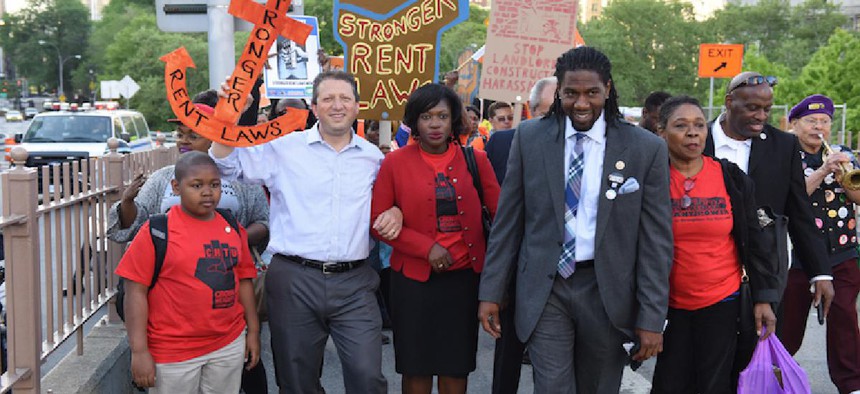In New York City, when economic times are good, both incomes and rents rise rapidly. When economic times are bad, incomes stagnate but rents continue to rise. And for low-income New Yorkers with incomes below twice the federal poverty line, rent rises faster than income no matter what. This is true in all kinds of neighborhoods and applies to both rent-regulated and unregulated tenants. That’s why the inflation-adjusted income per person left over after rent for low-income households was 8 percent lower in 2014 than in 2005 – just $13 and change per day to cover all expenses except housing.
This is not just a gentrification story. Rents do tend to rise fastest in neighborhoods in Upper Manhattan and in Brooklyn and Queens near the East River waterfront, and also in a few places further into Brooklyn like Bushwick and Bedford Stuyvesant, but the city’s affordability crisis is not confined to places like that.
Rent burdens for low-income people – the share of income that they pay in rent – are rising as fast in places like Morrisania and East New York as they are in Park Slope and on the Lower East Side. This is probably because some of the families with the worst rent burdens in gentrifying neighborhoods move out, which tends to lower the average burden in those neighborhoods, and then they move into poorer neighborhoods and continue to pay unaffordable rents, which tends to raise the average burden there.
These patterns are spelled out in a recent report from the Community Service Society, “Making the Rent 2016: Tenant Conditions in New York’s Changing Neighborhoods,” and the NYU Furman Center found similar trends in its recent report, “State of New York City’s Housing and Neighborhoods in 2015.”
In the CSS report, we also focus on the city’s one million rent-stabilized apartments and try to understand how low-income families end up with such crushing rent burdens despite the protections of the rent laws. This enables us to propose a solution that could provide significant relief to hard-pressed families.
By comparing average rents for various neighborhoods and apartment sizes in 2011 and 2014, and by considering whether the apartments had turned over during the period, we were able to dissect the total rent increase for most rent-stabilized apartments over the period. (We omitted rent-stabilized apartments in buildings built after 1974, because they are subject to regulation only because of subsidies and tax exemptions.)
We found that the total increase in monthly rent for 935,000 rent-stabilized apartments from 2011 to 2014 was $83 million, after adjusting for inflation. Almost half of that increase – $40 million – came from a single source, the automatic increase that landlords can add to the rent whenever an apartment becomes vacant. That’s $480 million a year. Tenant advocates call this the “eviction bonus” because it provides an incentive to landlords to induce their tenants to move out. Increases based on the decisions of the Rent Guidelines Board came in second, at $23 million a month.
What this means for low-income tenants is that whenever they must move within the city – perhaps because their household size changed or because conditions in their apartment deteriorated – they are likely to find new apartments with much less affordable rents. It is clear that moves, and therefore the eviction bonus, play a major role in raising rent burdens to their astronomical levels.
A bill introduced by Assembly Member Brian Kavanagh would end the eviction bonus, which would lower rents on vacant apartments in low-income neighborhoods and over time halt or reverse the surge in rent burdens.
This simple reform would do far more for low-income families than a continuation of the 421-a tax exemption for developers, which costs $1.1 billion a year to produce perhaps $100 million in affordability benefits. Our lawmakers in Albany should turn their attention away from costly tax boondoggles and toward common-sense rent reform.
Tom Waters is a housing policy analyst for the Community Service Society of New York.


